Last Updated on April 26, 2025 by Owen McGab Enaohwo

What if your business could run smoothly even when you’re not around? What if new hires could get up to speed without constant hand-holding? And what if costly mistakes caused by miscommunication became a thing of the past? These are all possible with one simple solution: process documentation.
When a business operates with clear processes, bottlenecks and inefficiencies become a thing of the past. Standardizing how tasks should be performed ensures consistency and clarity across the entire organization. Every employee follows the outlined steps, and training new hires on company processes becomes easier.
But here’s the challenge—starting from scratch can take a bit of time. That’s where free, ready-to-use templates come in. Instead of spending hours formatting and organizing, you can jump straight into documenting your workflows with these seven process documentation templates.
With SweetProcess, you can effortlessly create, manage, and refine your process documentation. Sign up today to access our templates and improve your efficiency.
Table of Contents
Why Are Process Documentation Templates Important in an Organization?
7 Free Process Documentation Templates in Word, Google Docs, and Excel
How To Write Process Documents [In 9 Simple Steps]
How To Create and Manage Your Processes Using SweetProcess
Process Documentation Examples To Inspire Your Team
8 Best Practices for Documenting Your Company’s Processes Seamlessly
What To Include in Your Process Documentation Template
Create and Manage Your Process Documents Effectively With SweetProcess
Why Are Process Documentation Templates Important in an Organization?
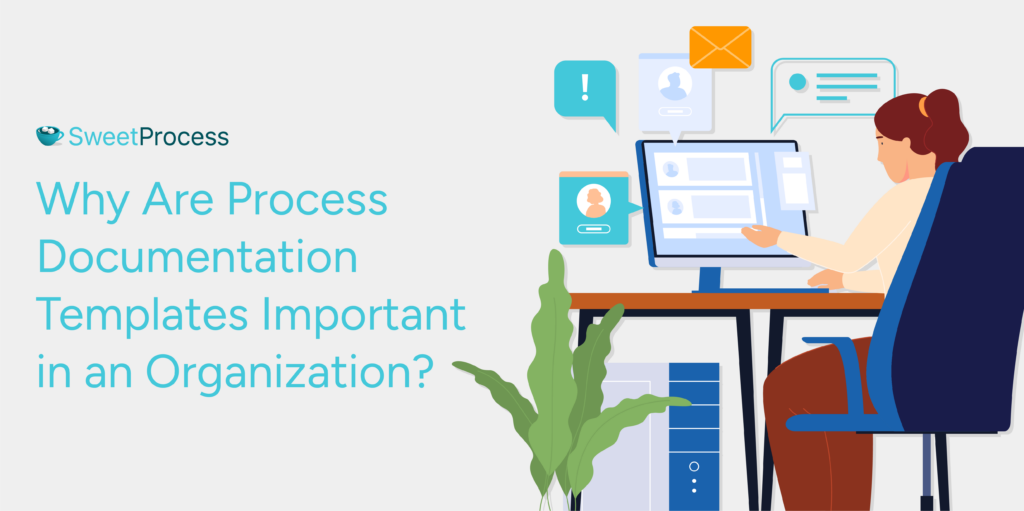
Organizations without clear processes run on guesswork, which leads to costly errors and quality issues. You don’t want to put your business in such a position. Here’s why you need to invest in process documentation templates.
Boosts Efficiency
Think of a chef trying to cook a complex dish without a recipe. They might get it right sometimes, but they’ll often waste ingredients, end up with an inconsistent result, or take longer. The same happens when you run your business without clear task completion steps.
However, with a structured template, employees don’t waste time figuring out what to do next. Instead, they follow a proven workflow that ensures tasks are completed faster. This translates to quicker project turnarounds and a more productive team.
Ensures Consistency
If every customer service agent at your company handles the same complaints differently, you will have frustrated customers and a damaged brand reputation.
Documenting a standardized process can avoid such confusion. This way, tasks are executed the same way every time, regardless of who is handling them. Using documentation templates creates uniformity; therefore, your business can maintain service quality and product standards without extreme variations.
Aids in Employee Training

According to the LinkedIn Workplace Learning Report 2024, organizations with a solid learning culture had a 57% employee retention rate. This data shows how valuable training sessions are in the workplace. One way to boost training is to document processes and make them accessible to all employees.
With the right template, you can create a training manual that captures all the tribal knowledge from seasonal employees. This information can guide new hires in executing their roles, speed up onboarding, and reduce training costs.
Supports Transparency and Accountability
Who do you blame when the product quality is inconsistent? Can you trace back how you got there? If tasks and processes aren’t clearly documented, it’s easy for employees to pass the blame when mistakes happen.
With a detailed process template, everyone knows their roles and responsibilities. There’s no ambiguity about who should complete a task, when it should be done, or how it should be executed. This transparency helps managers track progress and hold team members accountable.
Supports Progress Tracking
Think of process documentation like a GPS for your business. Without it, you can’t know if you’re on the right track.
Templates provide a structure to measure progress, helping managers track areas that require improvement and whether workflows are being followed correctly.
For instance, a marketing team can use a documented content creation process to determine the time it takes each stage, from research to publishing, and identify any bottlenecks slowing things down. By tracking these workflows, businesses can optimize operations and ensure continuous improvement.
Improves Clarity

If you don’t have an established way of doing things, employees may have different interpretations of how a task should be executed, leading to confusion. These misunderstandings are a huge problem for your organization because they slow down operations.
You need a process documentation template to remove ambiguity and provide step-by-step guidance. Your team will always be on the same page since they have a uniform reference point.
Enhances Decision-Making
Modern business managers overwhelmingly recognize the importance of data analytics in decision-making and planning. This perception has made data analytics a crucial aspect of the business process. However, data analytics are only as good as the quality and accuracy of the data that you use.
Consistent and accurate documentation helps reduce the possibility of errors in the data, thus leading to more informative analytics and beneficial decisions.
For example, if a sales team keeps accurate records of the business transactions, the managers can easily analyze the data, identify the fluctuations in sales numbers, and modify the approach if necessary. Without clear documentation, there won’t be adequate data to analyze, and the resultant decisions could have no impact at best or, at worst, harm the business.
Reduces Errors
Without clear documentation templates, employees can make costly data entry errors, such as entering incorrect data, omission of crucial details, or miscommunication. Documentation templates reduce the possibility of such errors by providing clear guidelines on the data they need to record and present to other employees, their supervisors, or stakeholders.
Also, in the unlikely event that an error occurs, the templates help the team to track the documentation, identify the errors, and fix them.
7 Free Process Documentation Templates in Word, Google Docs, and Excel

Having the right templates at your disposal makes documenting processes easier and faster. Here are seven free process documentation templates to help you standardize your operations.
Process Documentation Template
Your business has different workflows. A process documentation template can help you structure them in detail by outlining every step. You can add details such as the process name, objectives, step-by-step instructions, roles involved, and expected outcomes to keep your operations consistent.
Once you have this clear structure, you can eliminate errors and make processes easier to follow and replicate.
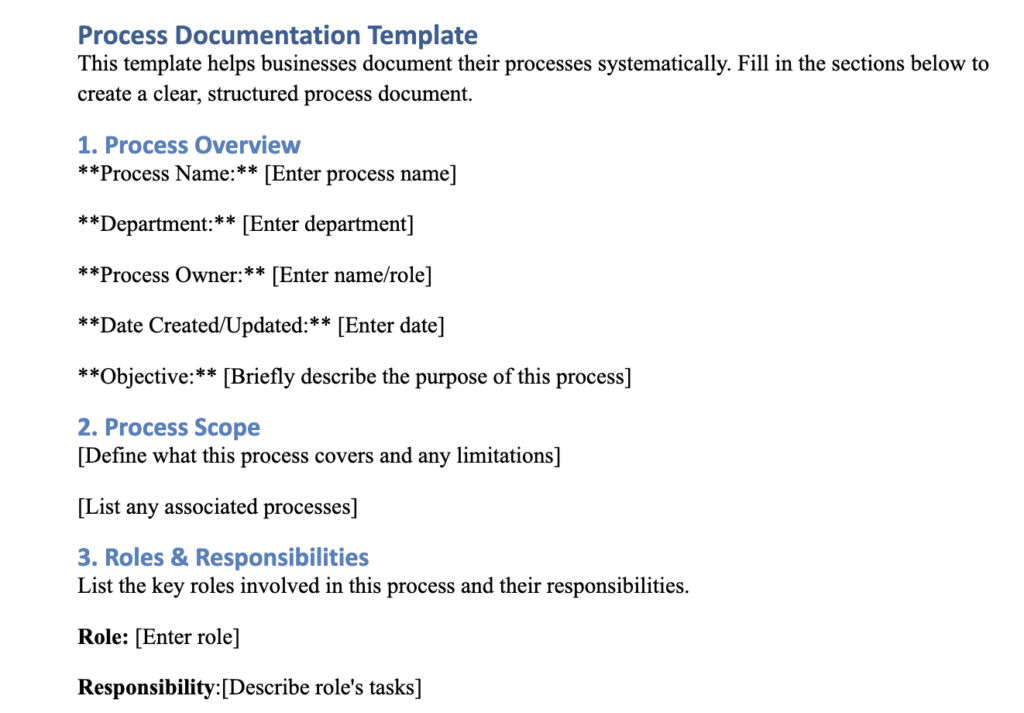
Download the Process Documentation Template
Process Workflow Template
You can use a workflow template to illustrate your business’s operations. On the template, you will map out each step or stage of the process and illustrate how the process flows from one phase to the next, leading to smoother operations.
The workflow template can also help to eliminate bottlenecks in your operations because it reduces confusion and delays. Such clarity is especially important for new employees or when different teams are collaborating on a project.
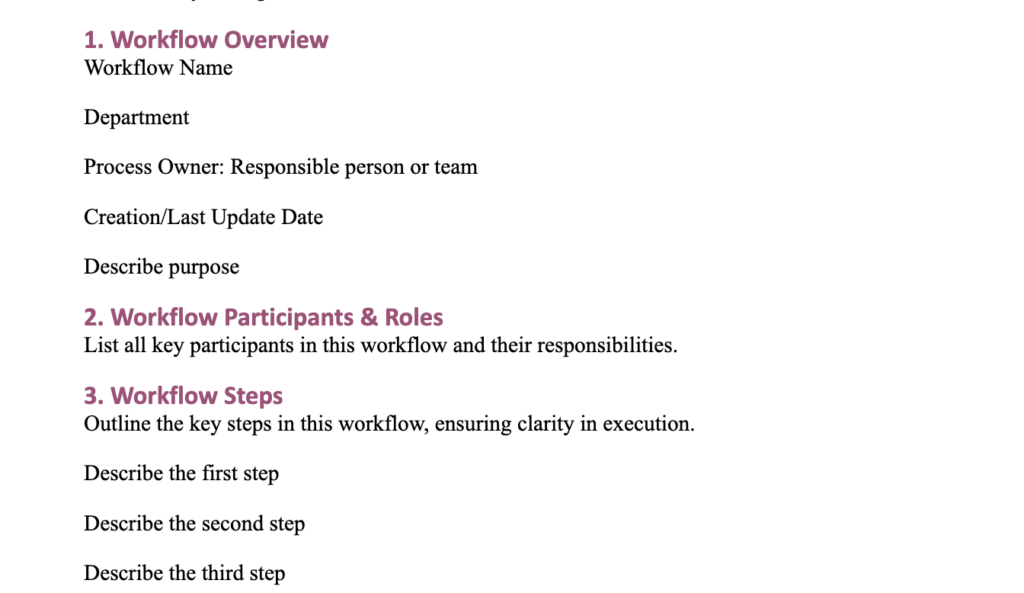
Download the Process Workflow Template
Process Flowchart Template
Instead of using text, you can use visuals to break down your processes. This approach makes it easier for your team to understand the documented processes at a glance. A process flowchart template offers a diagrammatic representation using symbols, arrows, and connectors.
It’s ideal for illustrating decision points, task dependencies, and the overall structure of a process.
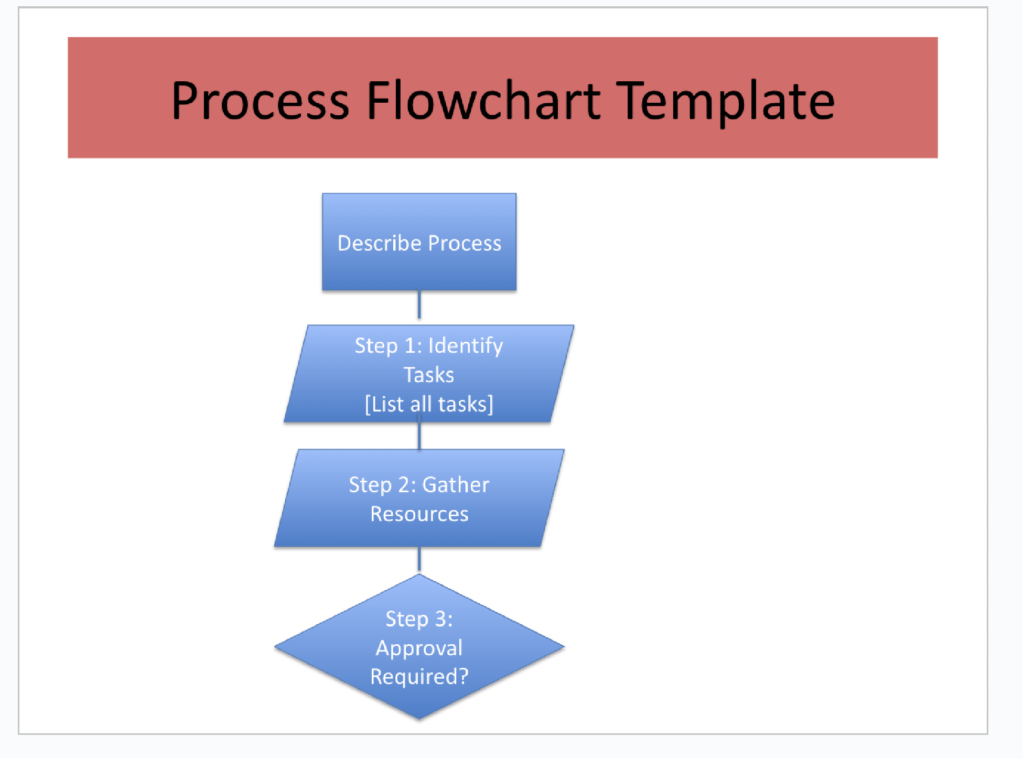
Download the Process Flowchart Template
Process Checklist Template
Checklists help you stay on track by providing a logical order to execute your work. You can use a checklist template to create these lists step-by-step so that nothing is overlooked.
This template is perfect for routine tasks such as employee onboarding, safety inspections, or quality control checks. By following the necessary steps, you can enhance your team’s productivity and accountability.
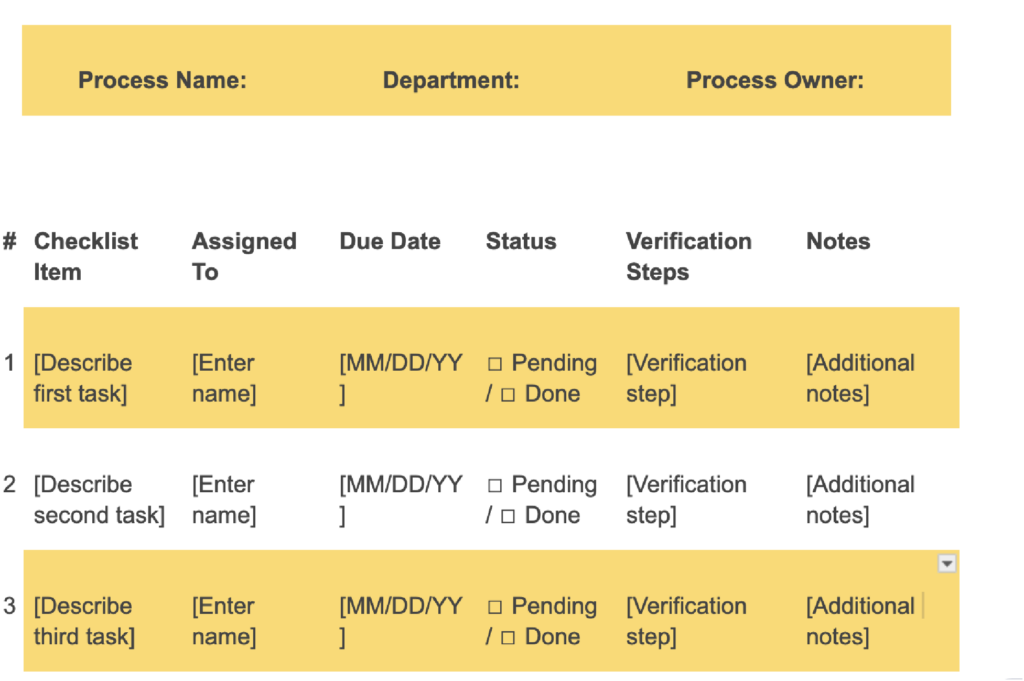
Download the Process Checklist Template
Business Process Documentation Template
This template can be used to document a comprehensive overview of your company’s processes. It can also document complex business processes such as supply chain management, financial reporting, or customer service workflows.
Some of the key things to include in this template are the purpose, scope, key stakeholders, process input, process output, and dependencies. This is one of the tools to use when you want to capture the critical details.
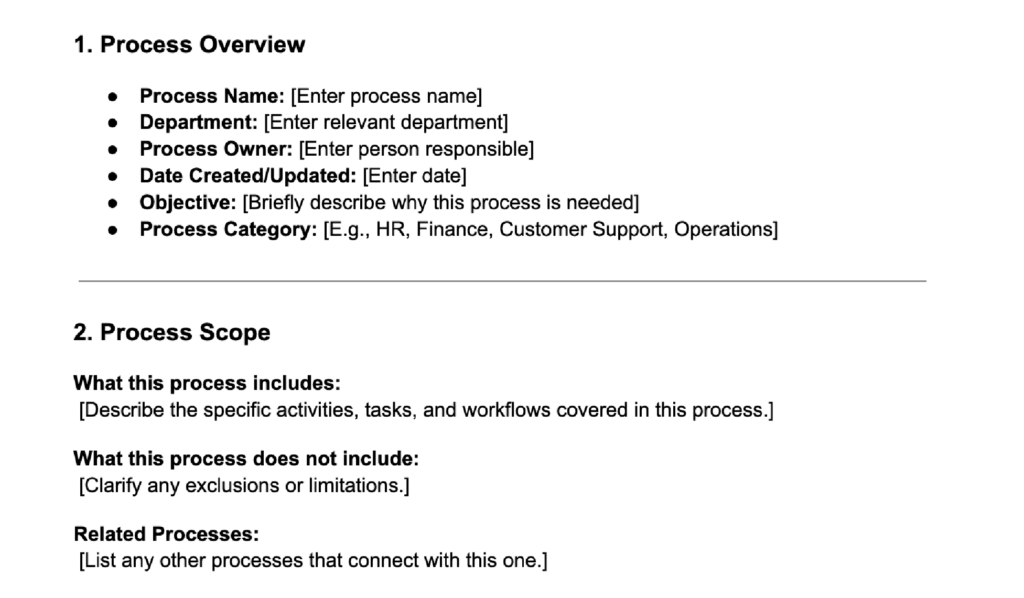
Download the Business Process Documentation Template
Standard Operating Procedure (SOP) Template
Every business is guided by standard operating procedures. These guidelines maintain compliance and standardize tasks in your organization.
An SOP template outlines how to perform a task or process step by step, including best practices and compliance requirements.
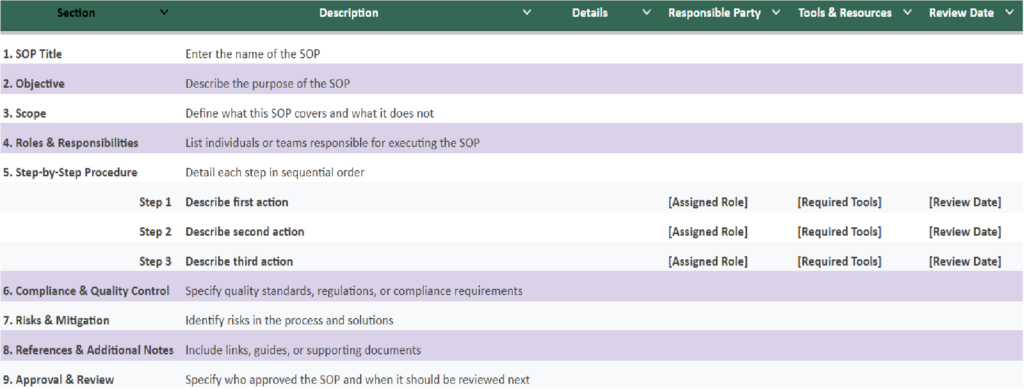
Google Docs Flowchart Template
This Google Docs flowchart template is a pre-designed format that allows businesses to create process flowcharts easily within Google Docs. It’s great for remote teams and businesses that need a cloud-based solution for creating and sharing process diagrams.
It allows for real-time collaboration, making it easier to update and share process flowcharts with team members from anywhere.

Download the Google Docs Flowchart Template
How To Write Process Documents [In 9 Simple Steps]
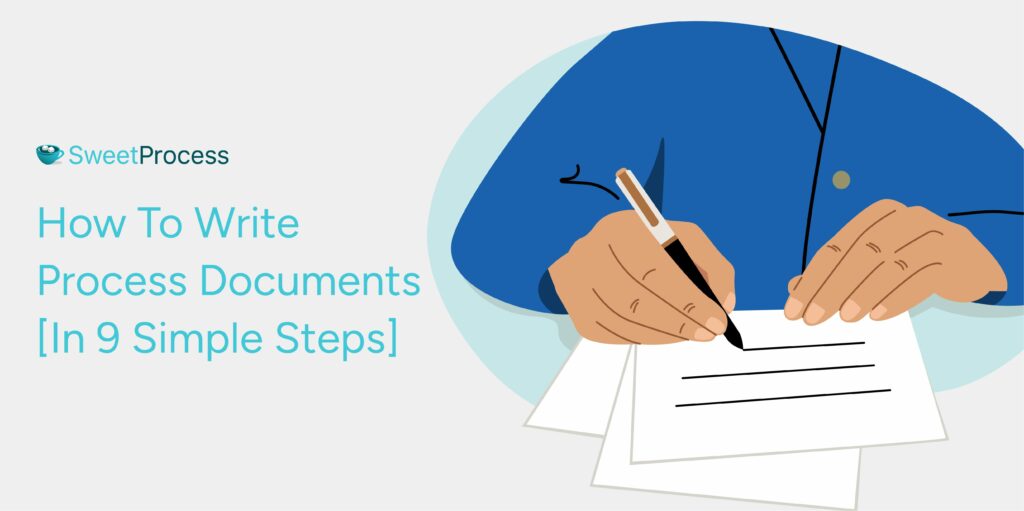
If you want to start documenting your process but are feeling stuck, we are here to help. Follow these simple steps to start writing your processes.
Define Your Goal
Every great process document starts with a clear purpose. Before you start drafting, consider:
- The problems that this process will solve.
- The individuals who will use this document.
- The outcome you want to achieve.
For example, when documenting an employee’s onboarding process, your primary goal should be to create a clear guide that new hires can use to learn your company’s processes quickly and accurately. Similarly, when documenting a customer support process, the aim is to ensure customers get their complaints addressed quickly and appropriately.
Such efficiency cannot be achieved if you do not set clear objectives when starting the documentation process. The lack of a clear goal makes it harder for your employees to perform their tasks satisfactorily. Make sure they understand the “why” before explaining the “how.”
Gather Your Documentation Team

You cannot create process documents alone. You need to involve the various employees and stakeholders who will execute or oversee the process on a day-to-day basis.
Some of the people you need to involve in the process include:
- Process managers
- Subject matter experts, i.e., the employees or contractors who understand the company process or the goals that the company is seeking to achieve.
- Writers and editors to help you edit, structure, and format the document for better readability and to ensure that it is clear, precise, and unambiguous.
For example, if you’re documenting a customer refund process, you’ll need input from customer service reps who handle refunds daily, the finance team, which approves and processes payments, and compliance officers, who ensure refund policies are met.
Collaborating with those who use the process daily boosts accuracy and relevance.
Research Tools and Requirements
Before you start writing, determine what’s needed to complete the process effectively. For instance, you should know:
- The software or platforms involved.
- The compliance requirements or industry regulations.
- The additional resources users will need, e.g., login credentials, specific templates, and approval steps.
Once you have this information, add it to the template and share it with your employees to avoid confusion.
Design a Template
Your template can be a flowchart, text, or table format, depending on your objectives. However, there are key things that every process documentation template should have, such as:
- Title: Clearly state the process name to make it searchable
- Objective: Explain why the process exists
- Scope: Define what’s covered and who it applies to
- Step-by-step instructions: Provide a logical, easy-to-follow breakdown
- Roles and responsibilities: Specify who is responsible for each step
- Tools and resources: List any required software, documents, or materials
A consistent template makes process documents easier to read, update, and apply across different teams. If your company uses process documentation software, you can create reusable templates and standardize workflows across all departments.
Write Your Documentation
Now, it’s time to put everything into words. But instead of drafting a block of text, it’s better to simplify it. As you draft your documentation, here are some best practices to guide you:
- Use simple, direct language. Avoid jargon that may confuse new team members.
- Write in a step-by-step format. Numbered steps or bullet points make it easy to follow.
Your process document should be understandable even to someone completely new to the task.
Add Visuals

Would you rather read a long paragraph describing a workflow or see a simple flowchart? Most people might process visual information faster than text, so adding visuals boosts how your team understands the process.
Here’s how these visuals benefit you:
- Flowcharts: They are ideal for showing decision-making steps.
- Screenshots: These are quite helpful for software-related processes.
- Checklists: They simplify task tracking.
- Tables: They help organize roles, timelines, or requirements neatly.
As you add these visuals, ensure that they align with your product or service. For instance, an IT troubleshooting process could include screenshots showing error messages and step-by-step fixes.
Peer Review
Even the best writers can overlook errors. Before publishing, have team members review the document to ensure accuracy and clarity.
Peer review is important because it prevents misinformation. You need a team member who is fully involved in the process to verify. You could also get a fresh set of eyes that can catch confusing or vague instructions. Additionally, reviewers may suggest missing steps or details to help remove inconsistencies.
Publish the Document
Once reviewed, it’s time to distribute the process document to the relevant teams. Ideally, you should publish the document in a centralized location that’s accessible to all the stakeholders.
Invest in a process documentation tool that allows managers and supervisors to assign tasks and train new employees from the main reference point.
Audit the Performance
A process document isn’t a “set it and forget it” tool. It needs regular updates to remain relevant. You can check whether employees are following the documented steps to determine whether the process is meeting its goal.
This is also the best time to gather feedback from your employees about any unclear or outdated parts. You can track key metrics such as error reduction and completion time, which will tell you whether your approach is working.
How To Create and Manage Your Processes Using SweetProcess

Managing business processes manually can be daunting if you have scattered documents and employees who are constantly asking for guidance. SweetProcess eliminates these inefficiencies by providing a centralized, easy-to-use platform for documenting, assigning, and managing processes.
Let’s explore how SweetProcess can transform your company’s process management.
Document Your Company’s Processes From Scratch
Every business runs on critical processes, whether you want to onboard new hires, handle customer support requests, or approve invoices. But without clear documentation, these workflows become inconsistent and prone to errors.
SweetProcess allows you to document any company process from scratch in a structured, step-by-step format.

Instead of keeping procedures scattered across emails, spreadsheets, or handwritten notes, you can create a standardized, digital repository where employees can access the most up-to-date instructions anytime by searching on the dashboard.
This way, you have no more outdated SOPs or knowledge silos.
Turn the Company’s Procedures Into Easy-to-Follow Processes
A process is only as effective as its execution. If employees can’t easily follow instructions, even the best-documented process will fail.
SweetProcess simplifies complex procedures by turning them into interactive, step-by-step workflows.
Instead of long, text-heavy manuals, employees can follow clear, visual guides with embedded checklists, videos, and screenshots—eliminating confusion and making learning effortless.
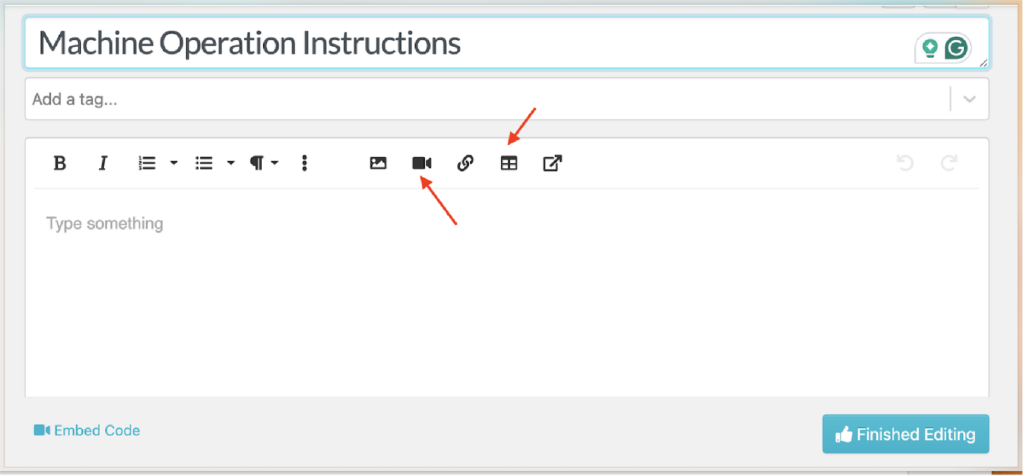
For instance, a growing e-commerce company can use SweetProcess to create a detailed order fulfillment workflow, outlining each step: inventory checks, packaging, shipping labels, and quality control.
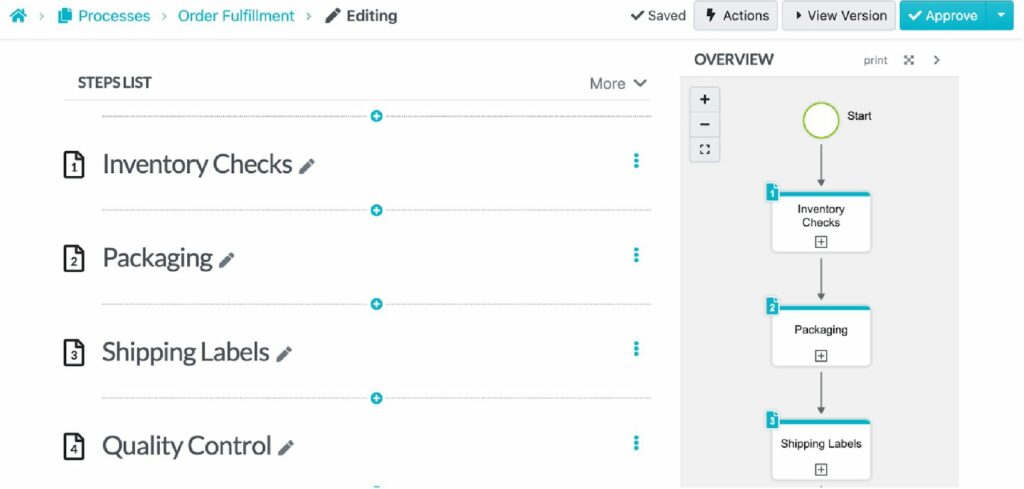
Now, every team member follows the same structured process, reducing errors and speeding up deliveries.
With these consistent procedures, you have fewer mistakes and faster onboarding.
Assign Processes as Tasks to Team Members
SweetProcess enables you to assign tasks to team members directly within the system, ensuring that responsibilities are clear and nothing slips. As you edit your process, you can select “Related Tasks” and assign it.

Alternatively, you can assign the process from the dashboard.
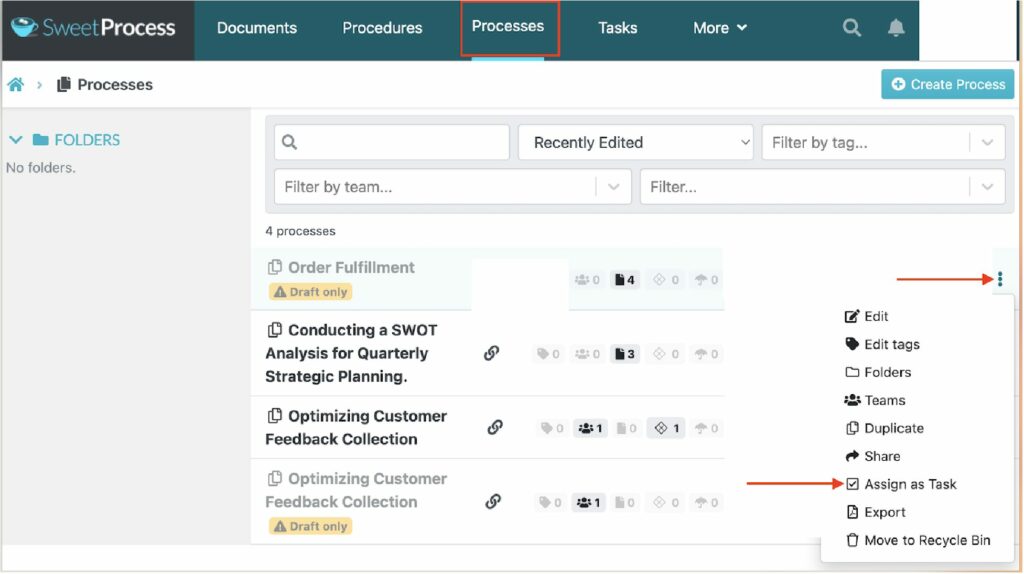
Managers can also track real-time progress from the “Tasks” menu on the dashboard, ensuring accountability and preventing bottlenecks.
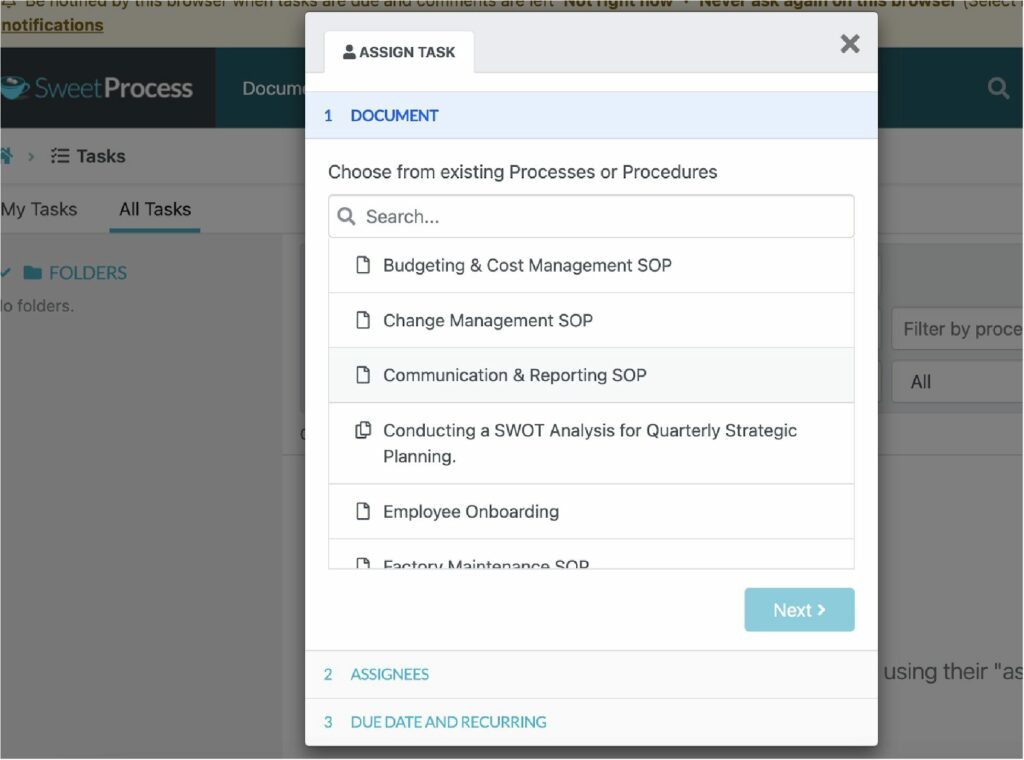
As you assign these processes, you can add the names of the assignees and due dates to ensure accountability.
Manage Your Processes in One Single Place
Most businesses struggle with disorganized process documentation. If your processes are stored by different employees, you’ll have no single source of truth. SweetProcess solves this by offering a centralized process management hub where every workflow, task, and procedure is stored, updated, and accessed in real time.
You can filter your results to get the specific process you need and take action.

When a team member updates a process, it’s saved on the cloud; therefore, everyone works with the latest version.
Thanks to these features, SweetProcess has been a go-to solution for several business owners looking to streamline their process documentation.
IT company XL.net helps small and medium-sized businesses manage their technology needs. Initially, the company struggled with process overload, documenting over 2,500 processes that overwhelmed employees and reduced efficiency instead of improving it. The excessive documentation led to confusion and outdated procedures that were difficult to manage.
Adam Radulovic, CEO of XL.net, soon realized they needed a streamlined workflow system and adopted SweetProcess after a recommendation from a client. This platform allowed them to simplify and centralize their business processes, significantly improving operational efficiency.
Here are the key measurable improvements after adopting SweetProcess:
- Seamless documentation process: XL.net eliminated outdated and redundant procedures, making process management easier.
- Quality assurance maintenance: Standardized process flow ensured consistent results across all operations.
- Employee learning and empowerment: A centralized knowledge base enabled faster onboarding and independent problem-solving.
- Simplified adaptability and operations: The user-friendly platform allowed teams to easily create, update, and follow procedures without a steep learning curve.
Spark Marketer has also benefited from SweetProcess. The company struggled with disorganization and a lack of standardized procedures, relying on tribal knowledge instead of documented processes. Because of this, employees often performed tasks inconsistently, and there was no objective way to measure performance or provide structured training.
The company experimented with Google Docs but found it inadequate. The co-founder, Carter Harkins, says that after discovering SweetProcess through a podcast, they adopted it to streamline operations and create SOPs that improved team efficiency.
So far, they have achieved:
- Simplified process documentation: Organized and structured SOPs replaced cluttered Google Docs, making workflows easier to follow.
- Decentralized knowledge base: Employees could quickly access relevant procedures without sifting through unstructured files.
- Seamless employee training: New hires and existing staff were empowered to find answers independently, reducing repetitive questions.
- Effective change management: Updates to processes were instantly reflected in the system, ensuring the team was always working with the latest procedures.
Process Documentation Examples To Inspire Your Team

Looking for inspiration? Here are examples of process documents created on SweetProcess to get you started.
Handling Customer Complaints
For instance, you can create a process for handling customer complaints for your support team. This document provides a standardized way to resolve customer issues.

You can include the relevant information to the process and add relevant visuals.
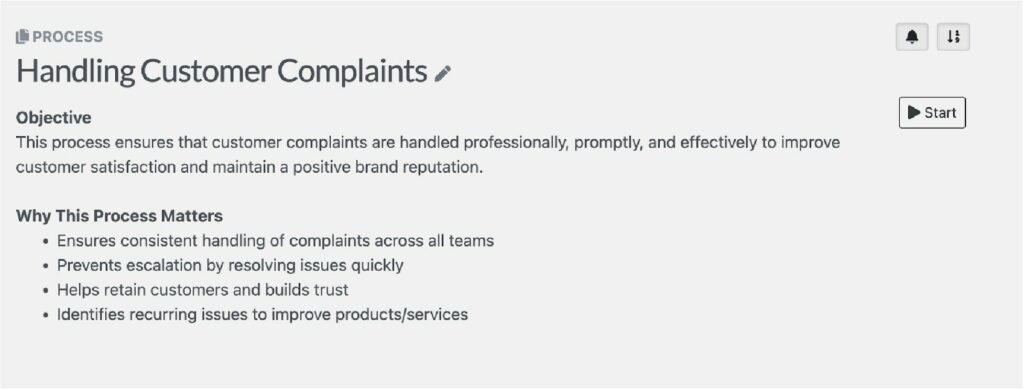
Additionally, you can add the steps or procedures your customer support team should follow in this process.
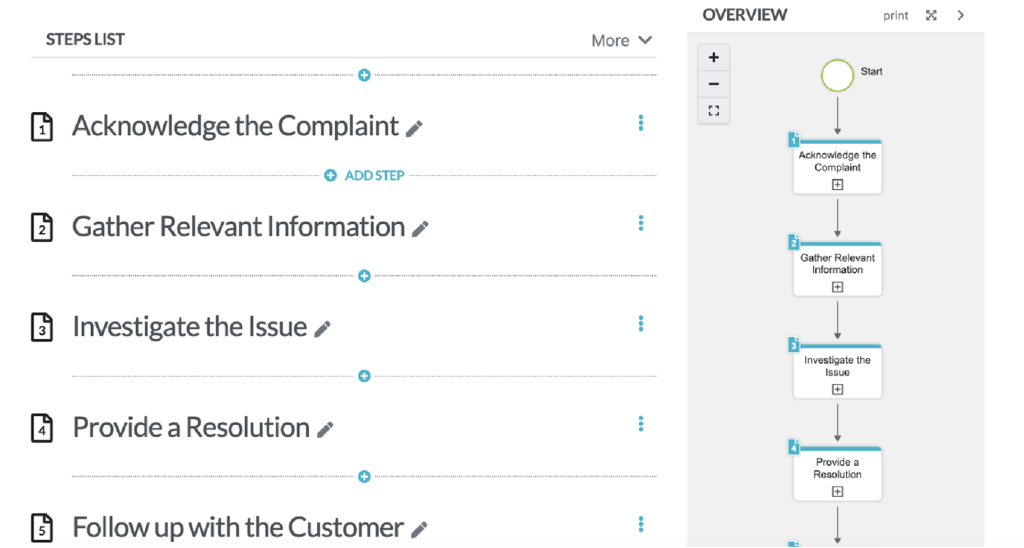
Content Writing & Approval Process
This process can outline the steps your marketing team should follow when researching, writing, reviewing, and publishing content, such as blog posts or social media content.
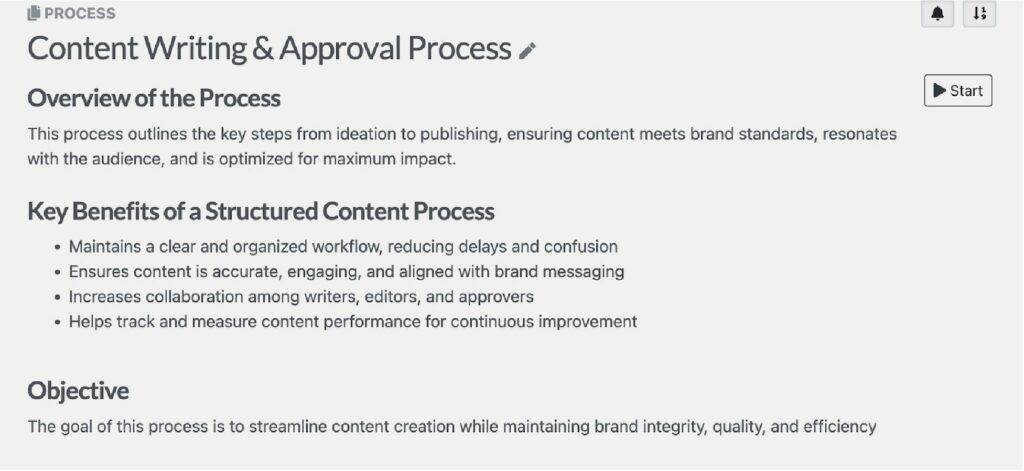
Quality Assurance Process
You need to follow a strict process to maintain product and service quality. This document enables you to maintain consistency and identify potential issues that might affect your quality standards.
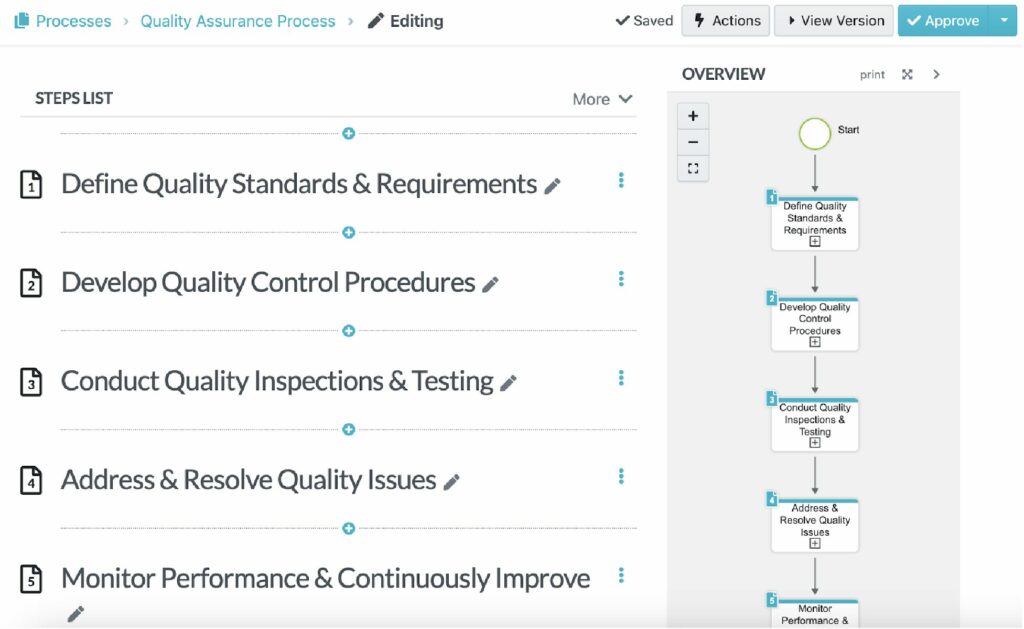
8 Best Practices for Documenting Your Company’s Processes Seamlessly

As you write company processes, they need to be clear and structured. Otherwise, you risk confusing your team much further. Let’s take a look at the best practices that will help you document your processes in a way that is accessible and easy to understand.
Use Templates Consistently
You will standardize your processes much better if you follow a template. Instead of using different structures, where one department uses text and another uses checklists, you should strive for uniformity.
Templates make it easier for employees to navigate different procedures without re-learning the format each time. You can go a step further and use more tools, such as an operations manual template for the entire organization, a work instruction template for training employees, and an action plan template to outline how you’ll perform all tasks.
With these templates, you can train new hires much faster and keep the team productive.
Keep Language Simple
Process documentation is meant to guide employees, not confuse them. If the language is too technical or complicated, employees may struggle to follow instructions, leading to the same mistakes.
Here’s how you can maintain clarity:
- Be direct and specific when writing instructions.
- Avoid complex terminologies unless necessary.
- Break down the information into steps and short sentences that employees can understand.
Include Visual Elements
Most employees will process visual information faster than text, making visuals a powerful tool in process documentation. Therefore, it’s better to add elements such as flowcharts to illustrate workflows, screenshots to show exact steps, and checklists to organize complex steps into an easy-to-follow format. You can also use icons and color coding to highlight important actions or warnings.
Update Regularly
Every industry keeps changing. You’ll have new technologies, government policies, or market changes that will affect your operations. Your processes should align with these changes. For instance, if you run a software or IT company, you must keep up with the changes and new protocols in the ever-evolving tech industry.
Using outdated process documents can lead to employees following incorrect procedures, causing inefficiencies and exposing your company to compliance risks. To keep up with the updates, you can:
- Schedule periodic reviews
- Assign a process owner responsible for keeping the document updated.
- Use process management software like SweetProcess to track updates automatically.
- Encourage employees to report outdated information so it can be revised in real time.
Gather Feedback
The process should be useful to the end-user. Therefore, if the documentation is meant for your employees, you should gather feedback from them to know if it’s effective. For instance, a warehouse manager is in a better position to notice if employees are frequently misinterpreting an inventory tracking process since he works with them throughout.
Apart from encouraging employees to report unclear steps, you can also hold regular check-ins or surveys to ask employees what could be improved. Once you have this information, you can refine the instructions.
Link Related Documents
Most business operations are interconnected, requiring employees to reference multiple documents. Instead of making employees search for related information manually, link relevant documents directly within your process documentation.
Here are some best practices for linking documents:
- Use internal links to connect related procedures, such as linking the “Customer Refund Process” to the “Returns Policy”.
- Create a centralized knowledge base where employees can quickly navigate between documents.
- Ensure links remain updated to avoid broken connections.
Make It Searchable
Even the best process documentation is useless if employees can’t find it quickly. Storing your processes in multiple folders inconveniences your employees. They may have to spend a lot of valuable time searching for instructions, which can be frustrating.
You can avoid this by using a centralized digital platform like SweetProcess, where employees can search for keywords and instantly find what they need. In addition, make sure the documents have clear, descriptive titles so that they are easy to find.
Test the Process
Before finalizing a process document, first check if it works by having someone follow it step by step. Testing helps identify missing details, unclear instructions, or impractical steps before employees rely on the documentation.
For instance, you can use an employee to follow the steps as documented and identify unclear instructions.
What To Include in Your Process Documentation Template

Now that you know the best practices to write your process documentation, what details should you add for it to be comprehensive? Here are the key elements to include.
Document Details
Think of this section as the introduction to your process documentation. It provides essential information that helps team members quickly identify the document, understand its relevance, and track updates.
This is the section to add:
- Your process name: Clearly state what the document is about. A good title might be “Customer Refund Process” or “Employee Onboarding.” This will make it searchable.
- Document owner: Specify the person or department responsible for maintaining the document.
- Dates: This information helps track how recent the document is and when it was last reviewed.
Your employees should get basic information about the process by reading this section.
Purpose Statement
Why does this process exist? Your purpose statement is essential because it:
- Explains the reason for the process.
- Highlights the benefits of following the process correctly.
- Clarifies what problem this process solves.
For example, an HR department documenting the new hire onboarding process might include this purpose statement:
“This process ensures that all new employees receive the necessary training, tools, and documentation to perform their jobs effectively. Following this structured onboarding reduces confusion, improves productivity, and enhances employee retention.”
Without a clear purpose, employees may view these documents as unnecessary bureaucracy rather than a tool designed to help them succeed.
Scope
Not every process applies to every department or employee. The scope section helps define who should follow the process and under what circumstances.
It’s the section to indicate who the process applies to, including the specific roles, teams, or departments. You can also add when the process should be used as well as any limitations. When employees have this information, they won’t waste time using the wrong process.
Procedure Overview
Your processes can be broken down into step-by-step procedures for better execution. A standard operating procedure template can help you create detailed instructions for your process.
Here are the key details to include:
- A brief explanation of how the process flows
- The main steps involved
- Any decision points that could change the course of the process
This approach prepares employees for what to expect when they dive into the details.
Process Details
This is the core section of your documentation. It contains the step-by-step instructions employees need to follow without confusion. This section includes a detailed breakdown of the process, who is responsible for each step, timeframes and deadlines, and required tools or software.
Each step should be concise, actionable, and easy to follow. This way, your team members don’t have to guess steps when executing the process.
Definitions
Processes often contain industry-specific or internal terminology that employees might not understand. It’s critical to prevent misinterpretations by including a glossary or key definitions in your process.
Ensure that you define uncommon terms or abbreviations used in the document. You should also clarify internal jargon that may not be familiar to new employees. This makes employee onboarding more seamless.
References
Many processes rely on other documents, policies, or regulatory guidelines. Instead of making employees search for related information manually, link or reference relevant materials directly. You can add references to external resources, such as government regulations and standards, such as ISO.
Therefore, when employees open a process document, they can click on the references and get detailed information to help them execute their roles.
Approval
These company processes are important to the business; therefore, they shouldn’t be created and modified at will. Adding an approval section ensures that processes are verified, authorized, and properly maintained by the right individuals.
For instance, if you are adding a budget approval process, you can add details such as:
- Document owner: Finance director
- Final approval: Chief financial officer
- Compliance verification: Legal team
- When was it last approved?
- Who is responsible for making updates?
This ensures that process documentation is accurate, up-to-date, and officially validated before employees use it.
Create and Manage Your Process Documents Effectively With SweetProcess
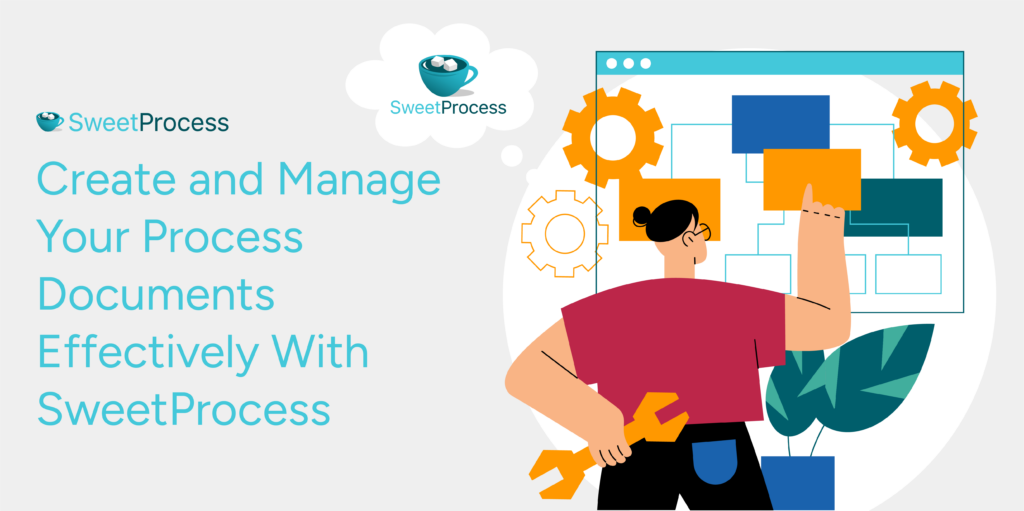
The most successful businesses share common factors. They are efficient and consistent. None of that happens by accident. It happens because they have well-documented processes that ensure every task is executed flawlessly, no matter who is responsible.
The right process documentation removes uncertainty, saves time, and ensures your business runs smoothly—even when key employees leave.
SweetProcess helps businesses break free from inefficiencies by providing a centralized, structured, and easily accessible system that keeps your operations running.
From streamlining onboarding to automating workflows and improving compliance, SweetProcess empowers teams to work smarter. Ready to eliminate inefficiencies and build a more productive business? Sign up here to get started!
